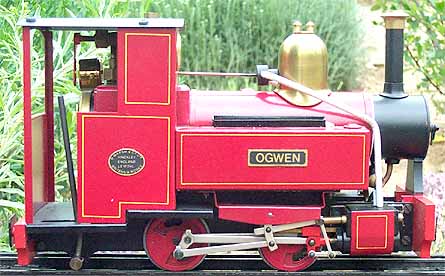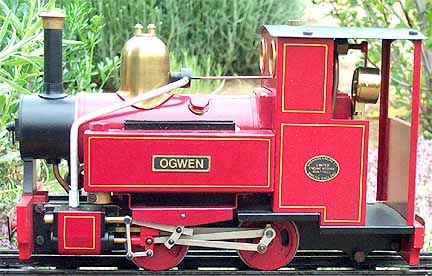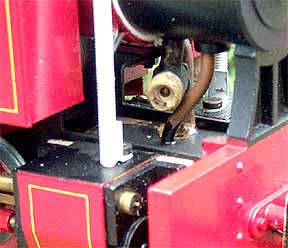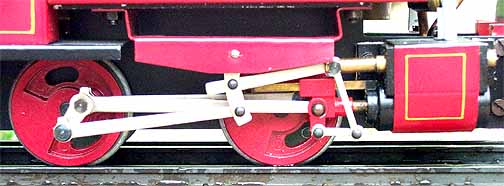
Back to Loco of the Month homepage
Back to Sidestreet Bannerworks
.
June 2005
Roger Marsh's Ogwen
by Marc Horovitz

Any number of small, relatively nondescript, industrial engines were built by a variety of British companies for use in stone and slate quarries, gravel pits, and other unglamorous occupations. Many are preserved today in far more glory than they ever experienced in their working lives, often hauling passengers on preserved railways, but never, today, doing the work for which they were intended.
Ogwen is one such engine. It, and a sister engine, Marchlyn, were built in 1933 for the Durham County Water Board. In 1936 they were both purchased by the Penrhyn Quarries in Wales, which owned many little engines of this nature. Ogwen worked there until 1965, when the quarry was closed. Later that same year it was prepared for shipment and was packed off to the USA for preservation, where it exists today, reputedly stored in Terre Haute, Indiana.
The model
Roger Marsh and his company Minimum Gauge Railways is perhaps best known for batch-produced 7+"-gauge models of various narrow-gauge locomotives. His "Tinkerbell" class is one that the driver actually sits inside.
Ogwen was Mr. Marsh's only entry in the commercial, small scale, live-steam field, although he initially had hopes of a whole range of engines, including mammoth K-class D&RGW locomotives. Ogwen was first introduced in 1982, to considerable acclaim. I became the US distributor for this engine in 1983. Unfortunately, Mr. Marsh fell on hard times and the last of the Ogwens was delivered in 1984, after a brief year in the sun. These last ones, alas, had evidently been assembled with little care as there were several problems with them, not the least being valves that were solid in the cylinders, which had to be removed with a hammer to be lapped.
The design was eventually acquired by Maxwell Hemmens, who was making a version of the Porter 0-4-0 at the time. Ogwen emerged from Hemmens' shops as a much-changed beast.
The original Marsh Ogwen is a pretty little engine. It features a pot boiler, lagged with a layer of ceramic paper, with an external, gas-fired burner. (The company also offered a similar burner for use in Mamod engines.) In the back of the boiler is a water window, and a pressure gauge is also fitted. Control is via a single lever in the cab, which operates a rotary valve under the steam block between the cylinders. A fitting is included beneath the boiler for filling it via an outside source. A displacement lubricator with a drain resides in the left-hand water tank and there is an odd filler plug on the left side of the boiler, so as not to foul the dummy throttle rod that travels from the cab front sheet to the steam dome. Other details include dummy steam pipes, made of threaded rod to simulate lagging.
The two 12mm-bore cylinders are controlled by piston valves. Dummy Walschaerts valve gear adorns the running gear. The front axle is sprung, a nice touch.
Ogwen was offered in a variety of colors, including red (most common, I believe), green, blue, and black. It is a simple, well-made engine, attractively finished.
The run
This was the maiden voyage for Ogwen. Yes, it has been sitting on my shelf since 1983, untouched. There is always trepidation and not a little regret in running a brand new locomotive, especially one that has never been tested on steam, even at the factory. No engine is quite the same after its first firing, as paint begins to disintegrate and the entire locomotive begins to take on the patina of a working locomotive.
I oiled it all around—after more than 20 years it was as dry as a bone. Then I filled the lubricator the first time, which was no easy task as the steam pipe obscured the opening. I pulled the plug in the boiler and added water up to the top of the glass, which may have been a little too much. Half a glass might have been better. I filled the tank with butane and lit the engine at one of the exhaust vents next to the boiler. The fire caught instantly. There was immediately that smell, unique to brand-new engines. It's mostly paint burning, I think.
It took a very long time for steam to come up, but it finally reached blow-off of around 30 psi. I optimistically took it outside to the track, which was a mistake. It was cold out and there was a howling gale. The fire immediately went out and no attempt succeeded in relighting it. This was obviously a fair-weather locomotive.
The next day dawned cool, sunny, and calm. I adjusted the air intake on the burner to increase efficiency, refilled the gas tank, and removed a little water from the boiler. The fire caught instantly and pressure came up in a much more acceptable time. I took the engine out to the track and pushed the control lever forward. It sputtered, ran a few inches forward, and stopped. I pulled the lever back, and Ogwen showed more signs of life in reverse. Forward once more, and we were off.
The engine likes to run fast and is difficult to get to run slowly without a load. The control lever is hard to use, being almost inaccessible in the full-forward position (which is too far forward anyway). However, once things were sorted out and the engine calmed down, it gave an excellent run of about 15 minutes. Control came as much from the burner setting as from the throttle. The gas tank, being above the boiler, heated up during the run, requiring several adjustments of the fire along the way.
This is a charming engine when behaving. There is a nice bark to the stack when running, and the burner, being external, is nearly silent. I discovered that the seal around the gas filler valve was damaged, causing a little leakage there. No doubt the run would have been longer if that problem had not arisen. All in all, though, it was a very satisfactory maiden run on a beautiful spring morning.
|
|
|
| Builder | Roger Marsh (Great Britain) |
| Date built | 1982 |
| Gauge | 0 (32mm) |
| Scale | 16mm = 1'0" |
| Boiler | Pot |
| Fittings | Safety valve, water glass, pressure gauge, filler plug, check valve |
| Fuel | Butane (external burner) |
| Blow-off pressure | 30 psi |
| Cylinders | Two, double acting, piston-valve |
| Reversing gear | Rotary valve actuated from cab |
| Lubricator | Displacement |
| Weight | 4 lbs. |
| Dimensions | Length over end beams, 8-1/4"; width, 3-1/4"; height, 5-1/2" |


Simple lines and a simple mechanism made this a good engine for beginners. The throttle/reversing lever can be seen in the cab at the left. The filler plug is oddly placed on the side of the boiler, seen in the right-hand picture. Proportionally, this is a reasonably scale model of the prototype.
.


Left: The plain interior of the cab. The little window in the backhead gives a clear view of the state of the boiler. Few engines of this limited level of sophistication were fitted with a pressure gauge. The red lever sticking down controls the gas, the tank for which is housed in the roof.
Above: Beneath the smokebox is a check valve that could be used to fill the boiler from an outside source, like a squeeze bottle.
.



.
Back to Loco of the Month home page
Back to Sidestreet Bannerworks home page
This page and its contents
Copyright Sidestreet Bannerworks, 2005
.